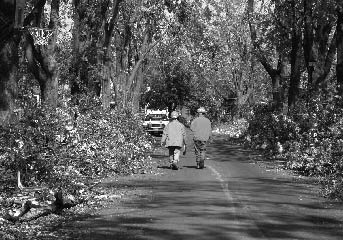Redefining Space
by Albert Chao

Much of the damage from the freak October storm has healed in these past weeks. Before clearing the debris, Buffalo looked like a city in ruin, with fallen branches rendering different parts of the city unrecognizable. Movement was confined by debris along the road and by the power outages that plagued the traffic lights.
Now, a walk through the parks, streets, houses and public areas reveal wounded trees, with missing limbs and warped branches. Stacked walls of tree branches and limbs along both sides of many roads create a condensed space for both viewer and driver. The clearing of debris reveals significant shifts in perspective; these changes have a profound effect on the environment.
Perhaps most devastating is the damage in Buffalo’s famous Olmsted parks. These six parks, designed by Frederick Law Olmsted, made up the nation’s first interconnected park system. Olmsted is credited as the founder of American landscape architecture, developing the park as a space that is equally accessible to all citizens. This plan is known internationally and is listed on the National Register of Historic Places.
The Buffalo Olmsted Park Conservancy will be working with University at Buffalo urban planning students to assess the damage and to develop plans for reforestation and renewal. The restoration process will be interesting in respect to other recent work in Buffalo. Restoration in landscape design is arguably as important as the restoration of key architectural history, such as Frank Lloyd Wright’s Darwin D. Martin House. Traditionally, and particularly in the case of historic landmarks, restoration focuses on re-creating the original in its exact form.
The difference between the two types of restoration is that buildings are made of fabricated materials. A tree cannot be replaced in the same manner. Trees are not prefabricated and static. Rather, they bring life, history and change to the space as they age. Landscape architecture is the hybrid of controlled planning and constant change.
According to the Buffalo News, Mayor Byron Brown predicts the possible removal of up to 3,000 of the 12,000 trees in the park system alone. However, the loss will not affect Olmsted’s original design, at least not in the long run. Joy Testa-Cinquino, representative of the Buffalo Olmsted Park Conservancy, says, “The trees will be replanted. The reforestation will not try to alter what was done by Olmsted.” In the meantime, the dramatic alteration to the landscape remains, having destroyed trees that are more than 100 years old. The parks will experience a gradual process of renewal to its original form. Testa-Cinquino estimates that “the effects will be felt for the next 20 to 30 years.”
Community involvement has been essential; this past weekend a few hundred people, including students from UB and local residents, volunteered their time to clear debris from the parks. Updated information on relief efforts will be announced on the Buffalo Olmsted Park Web site (buffaloolmstedparks.org).
In another ongoing effort, the Urban Design Project in the UB School of Architecture and Planning will document the damage to the trees in the Buffalo park system. According to a news release from the University at Buffalo, “the project will align comprehensive tree inventory work previously conducted by the conservancy with new aerial photography and proposed long-range plans. This work will form a base that then will be used to model graphically the extent of damage to the parks and parkway system in both GIS and 3-D simulations and to the setting of priorities for reforestation.”
Through the restoration process, space will be continuously redefined and reinvented. Change will grow alongside the built environment. For now, we clear the debris and wait until spring for rebirth and growth, once again changing and altering the recovery effort and space in general.
Meanwhile, relief efforts continue. This upcoming Sunday, November 5, Buffalo volunteers will be teaming up with Bona Responds, a disaster relief group from St. Bonaventure University, to clear and remove tree debris for families unable to do it themselves. This relief group will travel an hour and a half to reach Buffalo, and will start in Lancaster and possibly work in Delaware Park as well. Bona Responds has also been involved in relief efforts in New Orleans, where more than 250 students came together to help in the ongoing effort to address the hurricane damage to that city.
Nate Cornman, a senior UB architecture student, is rallying students—and the community in general—to join and help Bona Responds. Cornman explains that there is no need for previous experience or skills.
Cornman also has tremendous experience in relief work, having organized and planned two separate trips with UB students to the disaster-stricken areas of New Orleans. Cornman felt an eerie déjà vu in the wake of Buffalo’s storm: “I was so used to seeing the trucks in New Orleans. It brought back many memories. Typically, architecture studies can be more about individual design and work. Working with relief efforts, I feel like I am working with a larger community.”
Cornman was part of the initial relief efforts in Buffalo on October 22, when he and other volunteers helped clear debris at approximately 50 homes. Work plans for Sunday, October 29 were rescheduled to November 5 due to extreme winds.
Volunteers interested in helping out should meet Sunday, November 5 at the Lancaster Municipal Building, 5423 Broadway, at 10:45am. The crew will work until approximately 5pm, after which dinner will be provided, though there is no obligation for volunteers to stay the entire time. If there are any questions, please contact Nate Cornman through e-mail: ncornman@buffalo.edu.
Design Matters is presented in association with the UB School of Architecture and Planning and supported by a fellowship endowed by Polis Realty.
|
Issue Navigation> Issue Index > v5n44: The Common Council Sells Out (11/2/06) > Redefining Space This Week's Issue • Artvoice Daily • Artvoice TV • Events Calendar • Classifieds |









 Current Issue
Current Issue